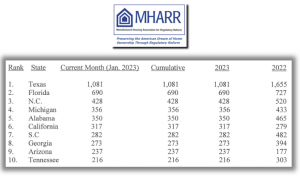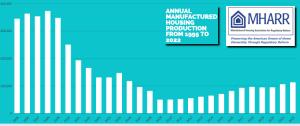Manufactured Housing Industry’s Washington, D.C. Update March 15, 2023
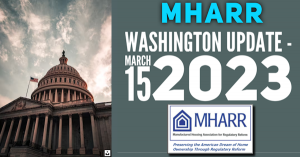
Manufactured Housing Association for Regulatory Reform (MHARR) Logo Washington, D.C. News Update March 15, 2023.
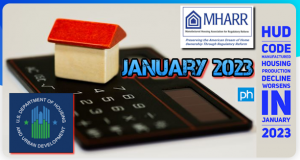
January 2023 official data reveals that HUD Code Manufactured Housing Production Decline Worsens In Jan 2023, per Manufactured Housing Association for Regulatory Reform (MHARR).
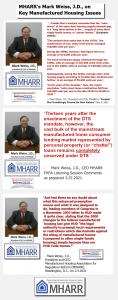
Mark Weiss, J.D., President and CEO of the Manufactured Housing Association for Regulatory Reform (MHARR) quotes on Key Manufactured Housing Industry Issues.
Washington, D.C. based Manufactured Association for Regulatory Reform (MHARR) Issues 7 Part Update News Release
MARCH 15, 2023
• DOE “ENERGY” RULE LAWSUIT FILED AFTER NINE MONTH DELAY
• FHFA CONTINUES TO THUMB ITS NOSE AT CONGRESS ON DTS
• HUD CONTINUES TO IGNORE ANTI-MH ZONING DISCRIMINATION
• HUD CODE PRODUCTION PLUMMETS
• MHARR SEEKS CONGRESSIONAL OVERSIGHT HEARINGS
• “NEW” IECC PROCESS WOULD WORSEN DOE ENERGY RULE
• MHARR WHITE PAPER CORROBORATED ONCE AGAIN
MHARR-PROMOTED LAWSUIT FINALLY FILED AGAINST DOE ENERGY RULE
Some nine months after the publication of a market-killing U.S. Department of Energy (DOE) final rule for manufactured housing “energy” standards – and more than six months after MHARR urged the Manufactured Housing Institute (MHI) to pursue legal action to stop the May 31, 2023 implementation of that rule (and simultaneously offered to join and support such litigation) -- MHI and the Texas Manufactured Housing Association (TMHA) have filed such an action in the United States District Court for the Western District of Texas [Case No. 23-cv-00174]. The DOE rule, as conceded by that agency, would add thousands of dollars to the retail cost of a new manufactured home, even without considering testing, enforcement and regulatory compliance costs, which have never been calculated or even estimated. Indeed, 2021-2022 MHARR estimates showed that the DOE standards would add between $6,000 and $12,000 to the retail cost of a new HUD Code home. Even those staggering figures, however, would be higher today, given continuing high rates of inflation and increases in living costs.
The pending lawsuit, accordingly, filed on February 14, 2023, seeks to stay implementation of the DOE final rule and other related relief. In both substance and approach, this court action tracks steps specifically urged by MHARR in August 2022.
In MHARR’s August 2022 Issues and Perspectives column, “Why the DOE Energy Rule Should be DOA,” MHARR detailed the legal bases and practical rationale for such a court action, as well as claims and arguments, both substantive and procedural (addressed in multiple sets of MHARR comments to DOE and the Manufactured Housing Consensus Committee), that could be asserted in such an action. It also stressed the urgent need for timely litigation in order to secure relief well in advance of the implementation date.
Among other things, MHARR called for an action under the federal Administrative Procedure Act, based on DOE’s failure to fully and properly calculate, account for, and consider all of the anticipated costs of the rule. This included, but was not limited to, DOE’s failure to propose and estimate the costs of testing, compliance and enforcement of the final standards, its use of artificially low inflation indices for the defective “cost analysis” that it did perform, and its failure to consider other factors that would result in costs substantially exceeding anticipated benefits. MHARR also urged litigation based on DOE’s failure to fully and properly consult with HUD and the Manufactured Housing Consensus Committee (MHCC) as directed by Congress in the Energy Independence and Security Act of 2007 and, just as importantly, DOE’s thoroughly corrupted “negotiated rulemaking” process, which MHARR consistently opposed (unlike MHI) and which irretrievably tainted the final rule from step-one.
As set out by MHARR, the objective of such a court action was to invalidate the DOE final rule – and the entirety of the rulemaking process which led to that rule, beginning in 2008 – and to compel DOE to go back to “square one” with respect to manufactured housing energy standards in full and proper consultation with both HUD and the MHCC, from the start, as mandated by Congress.
As this has unfolded, however, the MHI filing, which apparently follows the failure of other legislative and Executive Branch approaches pursued by that organization – the futility of which MHARR anticipated and explained in its August 2022 analysis -- appears to be a last resort, rather than the first step toward obtaining meaningful relief as urged by MHARR in its detailed blueprint. Consequently, while MHARR credits MHI for taking the necessary step of initiating court action against the DOE rule, that case should have been instituted months ago in order to avoid the type of chaos which has now begun to engulf the industry with, among other things:
(1) Uncertainty among manufacturers as to whether they must prepare for compliance with the DOE standards as of May 31, 2023;
(2) Corresponding uncertainty among IPIAs and DAPIAs regarding enforcement of the DOE standards and the scope of their authority (if any) in the absence of corresponding HUD standards (with at least one IPIA/DAPIA stating in a communication to manufacturers that it will not require compliance with DOE standards not incorporated within the HUD Code);
(3) A lack of any specific, valid action by HUD; and
(4) The absence of any type of testing, enforcement or other regulatory mechanism in advance of the May 31, 2023 implementation date.
Given the foregoing, the pending lawsuit must be about more than just delaying implementation of the final DOE standards rule. Rather, it must be about vacating that rule, based on its myriad fatal defects, and sending the entire rulemaking process back to the very start, so that there can be proper consultation with HUD and the MHCC, and complete elimination of the inherent taint that DOE’s thoroughly-corrupted “negotiated rulemaking” process infused into the process leading to the destructive May 2022 DOE final standard.
LATEST DTS REVISIONS CONTINUE TO FLOUT CONGRESS AND FEDERAL LAW
The Federal Housing Finance Agency (FHFA) – the federal agency responsible for the implementation of the Duty to Serve Underserved Markets (DTS) provision of the Housing and Economic Recovery Act of 2008 (HERA) -- has published the latest approved revisions to the 2022-2024 DTS “implementation” plans submitted by mortgage giants Fannie Mae and Freddie Mac. While these revisions will have some minor impacts on the manufactured housing market, they totally fail, once again, to address the complete absence of manufactured housing chattel loan support in the Fannie Mae DTS plan, or Freddie Mac’s ongoing delay of any DTS chattel loan support until the last year of its plan (2024) under a token pilot program that could still be deleted prior to implementation, as has been the case with previous supposed chattel loan “pilot” programs. MHARR has consistently cited this failure to provide essential support for the vast bulk of the manufactured housing finance market (i.e., nearly 80%) in comments that it has submitted to FHFA and Congress, and its ongoing engagement with senior FHFA officials.
Under Fannie Mae’s plan revisions, the structure of its DTS lending program for resident-owned, non-profit or government-owned manufactured housing communities would be slightly altered by eliminating specific performance subcategories for the three different types of ownership and instead aggregating all into one over-arching target. Beyond this, the update would also decrease Fannie Mae’s targets for loan purchases of manufactured home communities with “tenant site lease protections” over the entire three-year plan period, based on alleged “constraints in the macroeconomic environment.” Meanwhile, Fannie Mae’s DTS plan makes no provision whatsoever for support of the nearly 80% of manufactured housing purchase loans – disproportionately relied-upon by lower income minority groups – financed and titled as chattel.
For its part, Freddie Mac’s DTS plan revisions will increase targets for purchases of loans on manufactured homes titled as real property and communities with certain “tenant protections,” but does not increase or accelerate its minimal proposed 2024 chattel loan purchase pilot program.
Some 15 years, therefore, after the adoption of the statutory Duty to Serve mandate, Fannie Mae and Freddie Mac have purchased and/or otherwise supported exactly zero manufactured home purchase chattel loans – despite being expressly authorized by Congress to do so. Effectively, then, both Fannie Mae and Freddie Mac – and FHFA as their federal regulator – have totally ignored the nearly 80% of the affordable manufactured housing market served by personal property lending (according to U.S. Census Bureau data) and the millions of Americans who seek (and are being denied) access to the nation’s leading source of affordable homeownership.
This complete and ongoing failure on the part of both Fannie Mae and Freddie Mac is one of the two key constraints on the manufactured housing market, the greater utilization of manufactured housing and the availability of federal programs and federal aid for manufactured homebuyers (the other being discriminatory and exclusionary state and local zoning laws), as addressed in detail in MHARR’s July 2022 White Paper on the “Exploitation of Federal Housing Finance and Mortgage Funding Assistance Programs and Potential Solutions.” As such, this failure deserves thorough congressional oversight, including a hearing requiring Fannie Mae, Freddie Mac and FHFA to provide specific answers and remedies for this longstanding and baseless failure to comply with applicable law.
HUD COMPLETELY IGNORES EXCLUSIONARY ZONING AGAINST MH
The U.S. Department of Housing and Urban Development (HUD) has issued the latest proposed iteration of its so-called “Affirmatively Furthering Fair Housing” (AFFH) rule. Under the proposed rule, states and localities would be required to develop and implement “Equity Plans” designed not only to prevent housing discrimination against “protected classes,” but also to “proactively take meaningful actions to overcome patterns of segregation, promote fair housing choice, eliminate disparities in housing-related opportunities and foster inclusive communities….”
Insofar as the AFFH proposed rule – like previous proposed versions -- specifically cites restrictive “land use and zoning ordinances” as factors that “impede the development and maintenance of affordable housing commensurate with need,” MHARR has consistently called for use of the regulatory/funding powers conferred by AFFH and the enhanced federal preemption of the Manufactured Housing Improvement Act of 2000, to promote zoning that allows for the liberal siting and utilization of manufactured homes and, where needed, the invalidation of zoning mandates that discriminatorily exclude or restrict the placement of HUD Code homes.
Accordingly, in October 11, 2018 comments on an earlier AFFH proposed rule, MHARR urged HUD to:
“(1) Apply a modified AFFH structure to, among other things, seek the elimination of local zoning or placement ordinances that discriminatorily exclude or limit the placement of HUD-regulated manufactured homes and/or manufactured housing communities in compatible areas;
(2) Seek to prevent the adoption of any additional ordinances or measures of that type and/or effect; and
(3) Failing voluntary local compliance with such criteria, take action to federally preempt such ordinances or measures under the authority provided by both AFFH and the enhanced federal preemption of the 2000 reform law.”
Under AFFH, accordingly, HUD could – and should – use its authority to prevent and reject local zoning ordinances which exclude or otherwise discriminate against HUD-regulated manufactured housing. Such authority, moreover, is supplemental – and in addition to -- the authority that HUD already has to federally preempt such ordinances and “requirements” under the enhanced preemption language of the 2000 reform law, and which HUD must exercise, as anticipated and sought by Congress (as is explained in a 2003 communication from congressional proponents of the 2000 reform law to HUD).
Insofar, then, as discriminatory and exclusionary zoning continues to needlessly and baselessly restrict the role that manufactured housing otherwise would – and should – fulfill in meeting the nation’s need for affordable homeownership and non-discriminatory access for all Americans to such homeownership, and continues to prevent manufactured housing from fully and effectively participating in all federal government housing and homeownership programs, again as detailed in MHARR’s July 2022 White Paper, MHARR will submit comments in this rulemaking, once again urging the adoption of provisions that would allow for the invalidation and/or preemption of such zoning mandates.
MANUFACTURED HOUSING PRODUCTION PLUNGES
While the need for affordable housing and homeownership in the United States has never been greater, with millions more such homes required according to multiple market analyses, HUD Code manufactured housing production took a precipitous fall during the final quarter of 2022 and the first reporting month of 2023, according to official data compiled on behalf of the U.S. Department of Housing and Urban Development (HUD). Year-over-year production of HUD Code homes across the United States fell during each month of the Fourth Quarter, with the production decline becoming more severe as the quarter progressed. Thus, year-over-year production declined 6% in October 2022, 12% in November 2022 and 20% in December 2022. While total annual HUD Code production during 2022 still increased, due to strong growth early in the year, the Fourth Quarter saw an average decline of 12% year-over-year for the quarter as a whole, thus eclipsing the overall annual industry production growth rate of 6.7%. And, as if to put an exclamation point on the Fourth Quarter data, production statistics for January 2023 showed an even more precipitous 23.6% year-over-year decline, thus marking four straight months of steepening production declines.
While the cumulative annual growth in 2022 cannot be dismissed, the 20% production decline in December 2022, together with significantly weaker year-over-year industry production during the entire Fourth Quarter, extending now into 2023, should be a red flag regarding industry-specific impediments, such as discriminatory zoning exclusion and limitations, as well as the ongoing absence of federal support for fully-competitive consumer lending within the manufactured housing market in general and the personal property lending market in particular, which continue to suppress production levels well below where they should be, even in a virtually full-employment economy. Thus, while others in the industry may try to place a positive “spin” on these statistics, the fact remains that the industry, with these known, significant and unremedied post-production constraints, continues to underperform in a nation with: (1) a major documented shortfall of affordable housing; and (2) continuing significant inflation, which has placed site-built housing beyond the means of many American families.
This substantial production decline, in the face of accelerating need and demand, should be a sign to the industry and particularly its self-proclaimed post-production national representation, that a much more aggressive and effective approach is needed to address and, more importantly, remedy the discriminatory zoning and consumer financing constraints that continue to suppress the market and, more broadly, the availability of affordable manufactured housing for all Americans.
MHARR PRESSES FOR CONGRESSIONAL OVERSIGHT HEARINGS
In a recent communication to Rep. Warren Davidson (R-OH), Chairman of the House Financial Services Committee’s Subcommittee on Housing and Insurance, MHARR has called for full-scale congressional oversight hearings regarding the HUD manufactured housing program, the non-implementation of the Duty to Serve Underserved Markets (DTS) mandate by Fannie Mae and Freddie Mac.
The last time that an oversight hearing was held regarding the HUD program and specifically its failure to implement certain key aspects of the Manufactured Housing Improvement Act of 2000...
For the balance of the press release, see the link here.
Mark Weiss, J.D., President & CEO
Manufactured Housing Association for Regulatory Reform
+1 202-783-4087
email us here

